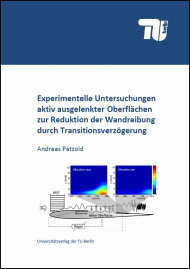Experimentelle Untersuchungen aktiv ausgelenkter Oberflächen zur Reduktion der Wandreibung durch Transitionsverzögerung

Publishing year: 2013
Any body exposed to a flow, generates drag forces. In order to minimize skin friction as dominating part of this overall drag, an extended laminar boundary layer flow is favorable. Laminar-turbulent boundary layer transition can be delayed by active and passive means. Here, an active laminarization method was developed and investigated in wind tunnel experiments. Transition on unswept two-dimensional wings is mainly caused by Tollmien-Schlichting (TS-) waves. A new method for attenuation of these convective instabilities was developed. The work was inspired by the visco-elastic properties of dolphin’s skin. Since no comparable material exists for air flows, these skin properties were simulated by real-time controlled actuators. Based on previous experiments with spatially limited actuation, an extended ‘active wall’ area as part of the wing’s surface was designed. It is able to generate travelling counterwaves. Different arrangements of piezo-membrane actuators were investigated with arrays of highly sensitive surface flow sensors and appropriate model predictive control strategies. Spanwise differentiated and streamwise cascaded actuation were used as well as inclined wall displacement. The onset of transition could be shifted downstream by 140 mm or seven average TS-wave lengths for a freestream velocity of u = 24,5 m/s. Two-dimensional and oblique boundary layer instabilities could be attenuated. Additionally, the investigation of the boundary layer flow downstream of the active wall area and an efficiency estimation are presented in this doctoral thesis.



